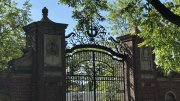When I interviewed for a postgraduate fellowship last fall over Zoom, one of the interviewers pointed out that during my time at Harvard, I’d co-founded four different extracurricular activities. “Why do you spread yourself thin by starting so many new things, instead of joining what already exists?” he asked me bluntly.
I had spent the weeks leading up to the interview inspecting my résumé like a microbe, preparing to summarize my involvement in each bulleted activity, elevator-pitch style. But I hadn’t considered the reasons for my involvement in the first place: why had I joined so many clubs at Harvard? More importantly, why did I find it necessary to create even more organizations at an institution where a surfeit already exists?
My various initiatives related to public service and journalism: Stories from the Border, a publication devoted to immigration and border journalism; Juntos (Spanish for “together”), a digital network connecting volunteers with immigration-assistance organizations; South Asian Americans in Public Service (SAAPS), a movement to promote public service among South Asian American students and allies; and Shakti, SAAPS’s affiliated journal of civic thought. At one point during my junior year, I combed through the ostentatious LinkedIn profile I’d curated online and observed that nearly every “experience” I’d added involved the word “founder.”
But I wasn’t alone. Many of my friends, as I gleaned from their profiles, were also founders, the word frequently appearing alongside “president.” After all, founding is often the easiest way to attain the presidency of an initiative—a smooth shortcut through the knotty, bureaucratic anatomies of Harvard student activities.
The general association between Harvard students and founding organizations isn’t surprising. Stiff competition for admission to elite schools means that more and more eager applicants are founding activities in high school, or even middle school—nonprofit organizations, social justice initiatives, apps, and start-ups. But why does the tendency persist even after a student is admitted?
My experience with extracurricular groups at Harvard wasn’t always rooted in founding my own. As a first-year, I quickly implanted myself in several, through “comps”—application processes that range from submitting writing samples to braving semester-long “tryouts.” Some comps are explicitly competitive; others purport to welcome anyone who successfully completes their requirements, even though those requirements can be grueling.
When I comped the news board of The Harvard Crimson during my freshman spring, I quickly realized that I had arrived one semester too late. My “guard,” or group of Crimson members who had comped in the same academic year, had largely solidified already: the fall-semester compers had developed a robust community enclosed in a bubble that I could not seem to penetrate. They were now staff writers covering dynamic beats, while I was still learning the basics of news journalism through weekly training seminars that ran throughout the semester. Perhaps most importantly, the fall compers were already close friends—some would even room together as upperclassmen—while I remained relatively unknown among them.
When the time came to apply to “senior beats” in the fall of sophomore year—the first step in scaling the rigid ladder of the news board—I knew I’d be limited to less glamorous options. This was in part because I’d written fewer articles than my fall-comper counterparts, but also because none of the organization’s leaders knew who I was. A fellow spring comper also noticed this, and attempted to make up for it by attending various Crimson social events. “I want clout in the organization,” he confessed to me one evening after a comp seminar. “Going to parties is the only way that people will know who I am. I can network.”
Cultivating friendships—and building networks—through extracurriculars is common, but I was struck by the extent to which clubs govern social life at the College. My friend Cassandra Luca ’21 coined the term “social phagocytosis” in her newsletter, elegant & devastating, to describe Harvard student organizations’ tendency to consume their members whole. “After enduring an interview, a writing sample, a case study, an entire semester of probationary activities, invitations to exclusive formals and dorm parties—why wouldn’t you choose to spend most of your hours either creating more club activities or hanging out with the same people all the time?” she notes pointedly. “Socializing within a club inherently means that there’s always a tinge of ‘work’ to it.”
As I navigated club social events, I noticed the subtle ways in which parties and mixers were considered markers of my commitment. More specifically, they appeared to attest to my capacity for leadership in the organization. When I joined the mock-trial team as a first-year, I quickly became enveloped by its social culture and was expected to attend team parties to solidify my place in the group. My attendance wouldn’t directly determine my leadership role in the organization, I was told, but I always felt that if I didn’t show up, I was losing a chance to get to know the other members who’d ultimately have a stake in my future role through annual board elections. On more than one occasion, a teammate told me I wasn’t present enough. I figured he was talking about my absence from the parties—not the practices.
As my first year unfolded, I became interested in dipping my toes in different kinds of student organizations. That spring, a friend persuaded me to apply to undergraduate-run consulting groups, prompting me to Google “consulting,” which I’d only begun to hear floating around in conversations the previous semester. Curious to learn more, I applied simultaneously to the two primary groups: Harvard College Consulting Group (HCCG) and Harvard Consulting on Business and the Environment (CBE), knowing that I could accept a spot in only one, if admitted to both.
I was struck by how similar—identical, really—the application processes were. Both began with a “résumé drop,” followed by an invitation to a first-round behavioral and case interview to “evaluate how [I could] think about a cutting-edge business problem.” After passing both groups’ first-round interviews, I was invited to their second-round interviews, in which I was to “complete a short case study” and present my findings to the groups’ boards. Ultimately, I was accepted by CBE and rejected by HCCG, which informed me in an email that it was “unable to move forward” with my application “at this time.”
A single semester of consulting prompted me to ask why two such groups even existed at Harvard. CBE ostensibly had a more environmentally conscious mission, per its name, although I was on a team working with a pharmaceutical company that was far from sustainable. But the groups seemed like clones, like the campus cornucopia of Model UN-type conferences and finance clubs. It all goes back to the question of founding. As Cassandra puts it, “Why join an existing club that has barriers to entry, or is highly socially exclusive, when you can start your own thing, erect your own arbitrary barriers, and put it on your résumé with the title of ‘Founder’?” It’s difficult to rise to the presidency of a student organization steeped in history and tradition—whether that’s the Crimson or the Phillips Brooks House Association, two of Harvard’s most popular. And at a school with prodigies and professionals among the student body, even joining a club can feel impossible.
For one thing, it’s rare to come across a club here that lets everyone in. Prior experience is often required: campus literary magazines aren’t meant for novice writers, most dance and choral groups are competitive, and the mock-trial team demands excellence in public speaking, among other talents that compers are expected to showcase during three rounds of tryouts. Even CIVICS, the volunteer group I joined as a freshman to teach Boston fifth-graders about American government, requires a written application and a competitive interview; I “passed” them both, but many of my friends, eager to advance an uplifting mission, did not.
Perhaps in reaction to such exclusivity, the groups I co-founded are generally inclusive: anyone can contribute to Stories from the Border and Shakti, volunteer with Juntos, or attend a SAAPS event, although certain internal processes remain competitive, like joining the executive boards.
Furthermore, they fill a void: there were no Harvard student groups focused on public service and writing in the South Asian American community, student publications devoted specifically to immigration and border storytelling, and centralized campus networks mobilizing and connecting volunteers with immigrant-support groups. But despite their inclusivity and, to a degree, novelty—at least within the College’s ecosystem—I still wonder: was it necessary to found these clubs in the first place?
When the fellowship interviewer asked his question, I offered a sincere answer—although I had further thoughts that I couldn’t summarize succinctly. Within the South Asian student community, I hurriedly explained, I felt the umbrella cultural and religious organizations often lacked a robust public-service component, prompting me to found SAAPS. Meanwhile, despite the crop of campus journalistic outlets, immigration issues remained overlooked or misunderstood, spurring my creation of Stories from the Border. I began to notice the impact of both groups early on: SAAPS events featuring prominent speakers engaged hundreds of South Asian American students across disciplines; Stories from the Border kindled a keen awareness of U.S.-Mexico border issues among undergraduates.
But another part of the answer, I think, has to do with the start-up culture that permeates student life here. Juntos, after all, was born out of winning the inaugural Institute of Politics Civic Tech Challenge—one of countless campus opportunities for undergraduates to take on the role of entrepreneur and pitch solutions to the world’s most pressing issues. For the Civic Tech Challenge, my teammates and I used the lessons we learned during a summer in southern Arizona to make the case for the volunteer network. Within its first year, Juntos had engaged nearly 100 students interested in volunteering with immigration organizations.
Juntos germinated from an idea into reality—and filled a void on campus—but there is a downside to Harvard’s pervasive founding culture. This past fall, I took a course called “Innovation in Science and Engineering” to fulfill my science requirement. The final project involved building the skeleton of a start-up in any field. My team of four—two students studying computer science, one studying statistics, and I, the lone humanities concentrator—designed a start-up focusing on accessible “ghost kitchens”: alternatives to brick-and-mortar restaurants that could alleviate food insecurity in low-income communities. One teammate suggested entering our concept in various extracurricular hackathons we’d heard about, as well. He reasoned we might win seed funding to build out our proposal.
The effort required to submit our pitch was minimal: often, simply filling out a Google Forms document and summarizing the purpose of our start-up was enough. To our surprise, we found out in February that we had won first place in one of the hackathons. But instead of seed funding, the grand prize was four $500 Dyson® air purifiers, to be shipped to each of us in the mail.
Weeks passed and I forgot about the air purifier until it arrived early in April, in a bulky, white cardboard box with no return address. I had no use for an air purifier; Harvard had equipped my dorm room with one at the beginning of the semester. A few days later, a friend who came over asked about the prize sitting in the corner of my room, and I explained that I’d won it through a start-up pitch competition.
“I didn’t know you had a start-up,” she said. “That’s really cool.”
“I don’t,” I clarified. “It never came to fruition. The prize was awarded just for the idea.”
“Oh,” she said, hesitating before trailing off. I felt a leaden silence balloon between us. The next morning, I walked to the UPS Store on Massachusetts Avenue and shipped the air purifier home.









